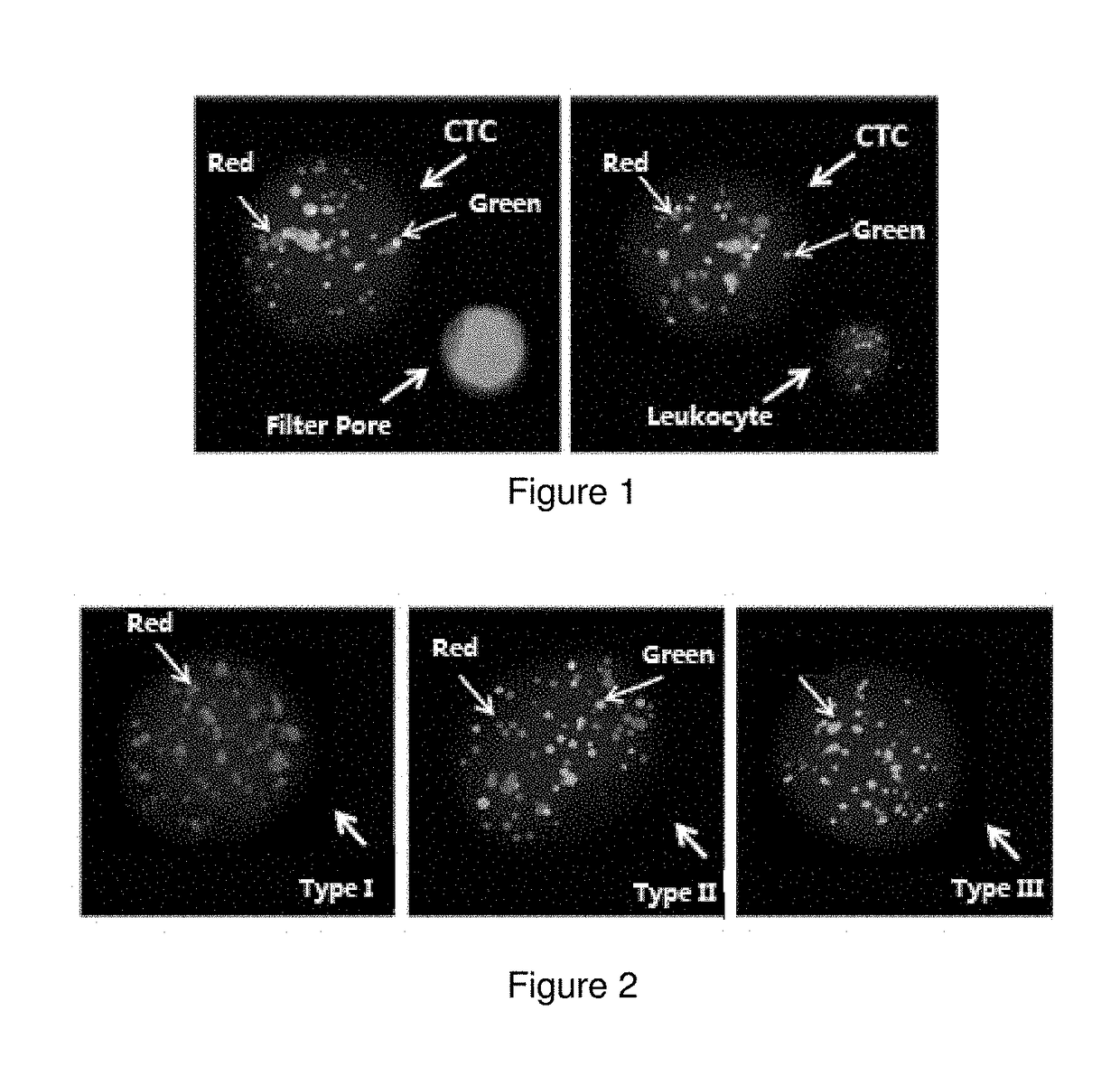Circulating tumour cell typing and identification kit
a tumour cell and identification kit technology, applied in the field of molecular biology, can solve the problems of increased mortality risk of malignant tumour patients, false positive or false negative detection results, and neoadjuvant chemotherapy did not eliminate the ctcs in which emt had, so as to reduce false negative results, reduce false positive results, and improve detection sensitivity.
- Summary
- Abstract
- Description
- Claims
- Application Information
AI Technical Summary
Benefits of technology
Problems solved by technology
Method used
Image
Examples
example 1
[0039]The circulating tumour cell typing and identification kit disclosed in this example can take two forms, either with or without a labeled probe.
[0040]A circulating tumour cell typing and identification kit A with a labeled probe mainly comprises:
[0041]I. Capture Probe
[0042]A capture probe consists of three components from 5′-terminal to 3′-terminal in sequence: a sequence P1 which complementarily pairs with corresponding marker gene mRNA, a spacer arm sequence, and a P2 sequence that is able to complementarily pair with a P3 sequence of a corresponding amplification probe, wherein the same P2 sequence is used in capture probes for marker genes of the same type. The spacer arm separates the P2 sequence of a capture probe from the target mRNA. A spacer arm sequence of appropriate length is usually provided within a probe to reduce steric hindrance and improve hybridization efficiency and specificity. The spacer arm of a capture probe of the present disclosure is preferably 5-10T,...
example 2
Detection of Circulating Tumour Cells in Peripheral Blood of Tumour Patients Using the Kit A According to Example 1
[0052]The formulations of the various solutions are listed below:
Name of solutionFormulationPreserving16.6 g NH4Cl, 2 g KHCO3, 8 ml 0.5M EDTA, filled to 1 L with ultrapuresolutionwaterFixing agent10% Neutral formalinPBS2.9 g Na2HPO4•12H2O, 0.3 g NaH2PO4•2H2O, 8.06 g NaCl, 0.2 g KCl,filled to 1000 ml with ultrapure water, pH7.4Permeabilization0.25% TritonX-100agentDigestive enyzme1 ug / ml proteinase KProbe buffer100 μg / ml denatured salmon sperm DNA, 100 mM LiCl, 0.1% sodiumsolutiondodecyl sulfate, 9 mM EDTA, 50 mM HEPES (pH 7.5), 0.05% ProClin300Amplification6 mM Tris-HCl (pH 8.0), 1% sodium dodecyl sulfate, 1 mL / L bovinebuffer solutionserum albumin, 0.05% ProClin 300, 0.05% sodium azideColor-developing20 mM Tris-HCl, 400 mM LiCl, 1 mL / L Tween 20, 1 mL / L bovine serumbuffer solutionalbumin, 0.05% ProClin 300Probe mixturei.e., capture probe, 0.75 fmol / ul / genesolutionAmplifi...
example 3
Detection of Cell Lines Using the Kit A According to Example 1
[0106]I. Selection of Cell Lines
[0107]In the kit of present disclosure, the epithelial cell marker genes are two or more selected from the group consisting of EPCAM, E-cadherin, CEA, KRT5, KRT7, KRT17, and KRT20; the mesenchymal cell marker genes are two or more selected from the group consisting of VIMENTIN, N-cadherin, TWIST1, AKT2, ZEB2, ZEB1, FOXC1, FOXC2, SNAI1, and SNAI2; and the leukocyte marker gene is CD45. The epithelial marker genes, mesenchymal marker genes, and leukocyte marker genes provided in this disclosure are genes selected by the inventors through numerous experiments and statistical analysis that specifically express on CTCs, with good specificity and accuracy for identification and typing of CTCs.
[0108]In this example, an epithelial type cell line MCF-10A, a mesenchymal type tumour cell line U118, and a mixed epithelial-mesenchymal type lung cancer cell line PC-9 were used for experiments, while CCRF...
PUM
| Property | Measurement | Unit |
|---|---|---|
| Magnetic field | aaaaa | aaaaa |
| Temperature | aaaaa | aaaaa |
| Volume | aaaaa | aaaaa |
Abstract
Description
Claims
Application Information
 Login to View More
Login to View More - R&D
- Intellectual Property
- Life Sciences
- Materials
- Tech Scout
- Unparalleled Data Quality
- Higher Quality Content
- 60% Fewer Hallucinations
Browse by: Latest US Patents, China's latest patents, Technical Efficacy Thesaurus, Application Domain, Technology Topic, Popular Technical Reports.
© 2025 PatSnap. All rights reserved.Legal|Privacy policy|Modern Slavery Act Transparency Statement|Sitemap|About US| Contact US: help@patsnap.com



